Henri Bendel: The Spirit of Paris in American Fashion, 1916
📌 Explore the elegant world of Henri Bendel, whose 1916 fashion designs captured the romance of Paris and defined modern femininity. Ideal for students, teachers, historians, and genealogists researching early 20th-century fashion and its role in transatlantic culture.
Henri Bendel has indeed proven to be a friend of France. His loyalty is practical, and letters from Paris tell us that he is supporting many destitute French families. Knowing about the poverty among the young working women of Paris, Mr. Bendel has donated large sums and collected thousands of dollars for their relief.
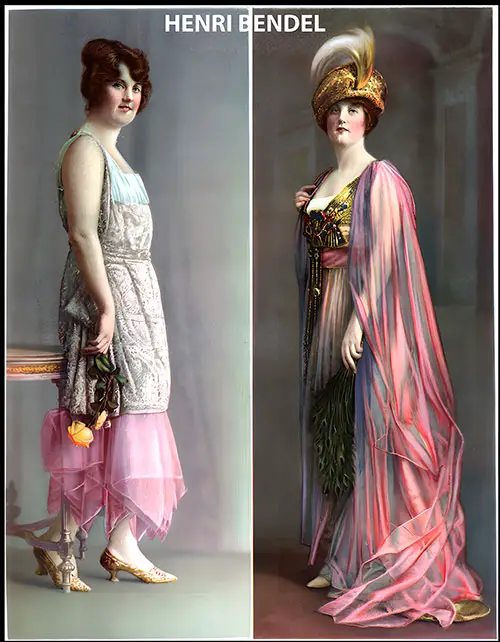
Gowns symbolizing Youth and Romance – Designed by Henri Bendel. Photographs in Color by The Campbell Studios, New York. Harper's Bazar, February 1916, p. 80. GGA Image ID # 1ca474a067
Henri Bendel: Bringing Paris to New York, One Gown at a Time
This stunning collection from Harper’s Bazar (1916), curated by GG Archives, spotlights Henri Bendel as a premier tastemaker who bridged Parisian haute couture and American high society at the height of the WWI era. Through vibrant imagery, lyrical descriptions, and fashion journalism, the article offers a portrait of Bendel’s design philosophy—one rooted in elegance, adaptability, and a timeless French spirit.
🎯 Why it matters: This article is invaluable for exploring the role of fashion in cultural identity, transatlantic influence, and how wartime solidarity, artistic craftsmanship, and innovation intersected in couture.

Long Pointed Flounces on an Absinthe Colored Chiffon Foundation Make This Evening Gown by Bendel a Thing of Beauty. The Pointed Bodice, Joining Under the Arms, and Over Skirts Are Bound With Silver Ribbon. A Silver Lace Petticoat Is Part of the Gown. The Underbodice Is of the Silver Cloth and Tulle. Harper's Bazar, January 1916, p. 51. GGA Image ID # 1ca5d5f176
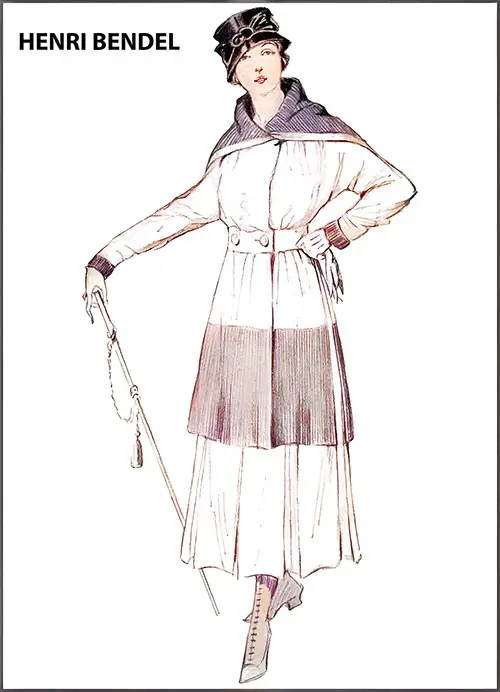
Sweater Material Is Here Used for This Unusual Sports Suit by Bendel. The Coat Has a Deep Border, Cuffs, and a Shawl Collar of Rose Colored Corduroy. The Light Weight and Warmth of This Material Make It Especially Valuable for Walking Suits. Harper's Bazar, January 1916, p. 51. GGA Image ID # 1ca57fdc28
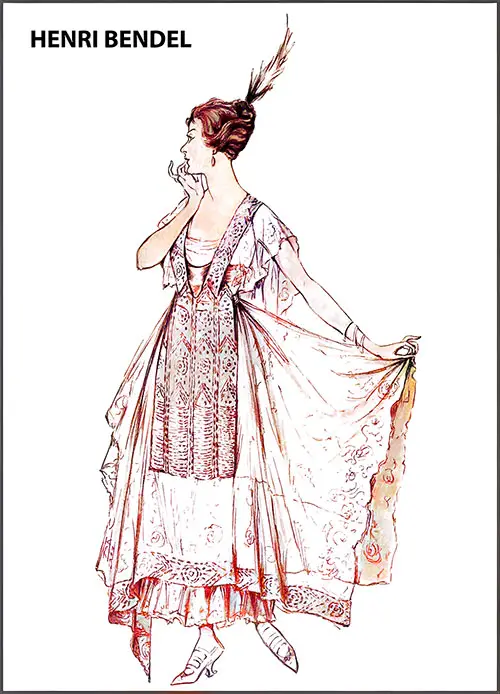
Effective Is This Dinner Dress by Bendel of White Satin With an Over Dress of Net Embroidered in Silver Beads and Edged With Light Silver Lace. The Tunic Is of Net Heavily Embroidered in Beads. Silver Lace Is Draped Shawl Fashion in the Back and Over the Shoulders. Harper's Bazar, January 1916, p. 51. GGA Image ID # 1ca6e5cc3d
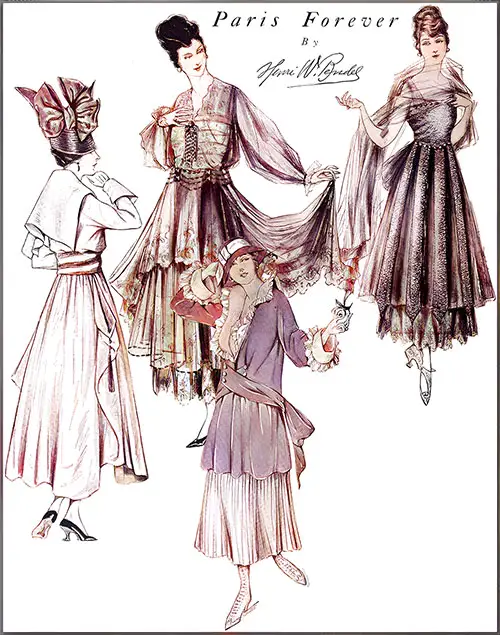
Paris Forever -- Fashions by Henri W. Bendel. Harper's Bazar, February 1916, p. 80. GGA Image ID # 1ca4734bc1
- Bendel masterfully incorporates paillettes, a timeless fashion element. They adorn the bands on the tulle and lace skirt and form the bodice of this exquisite dancing gown. The delicate tulle scarf elegantly transforms into sleeves.
- The white charmeuse dress on the left is distinguished by its exaggerated collar and huge pockets. The Roman striped silk girdle adds a touch of vivid coloring.
- Henri Bendel used black lace and tulle edged with jet for the skirt of this semi-evening dress in the center sketch. The bodice is a lovely old blue taffeta under black lace and tulle.
- The sash, crossing in front and fastening in the back, is the unusual feature of the sports coat of ashes of roses velvet worn over a white serge plaited skirt.
Paris Forever
The finer instincts for fewer Modes are inherent in the French alone. In acknowledging the distinction of the Paris designer, the world pays tribute to an incomparable and unique genius. A genius can be seen in the corset, the crinoline, and the little black dress, all innovations that have left an indelible mark on the fashion world. This genius, born from the ambient traditions of beautiful women and brave cavaliers, drawing inspiration from the matchless treasures of art and priceless documents accumulated by generations of connoisseurs in this beautiful city, continues to flourish and inspire.
When Napoleon seized the art collections of Europe, his conquests were measured not just by the extent of his territorial gains, but also by the richness of his spoils. This act laid the foundation for modern art and sparked a revolution in the fashion industry. The exquisite fabrics and delightful designs for women's clothing that he introduced to the Louvre were a testament to his profound influence on fashion.
Even in the face of political upheaval, the spirit of French fashion remained unyielding. Despite the tumultuous days of the restored monarchy, with revolutions and riots erupting as the nation grappled with its identity, the French capital managed to maintain its status as the birthplace of fashion, a testament to its enduring appeal and global recognition.
Such turmoil was mirrored in the eccentricities of the dress. However, with the advent of the Second Empire, a change for the better was on the horizon. An effort was made to restore the brilliance and elegance of the reign of the first Napoleon, and Empress Eugénie strove to reestablish the French court as the fashion dictator. Yet, the Empress faced a formidable rival in England, Queen Victoria, whose ideas about women's attire held significant sway and withheld part of her sovereignty in fashion from Paris.
Yet, France's genius was not to be subdued. It began to radiate and dazzle until it once again captured the world's attention. Before long, admirers from every corner of the globe were flocking to the doors of Paris couturiers, a testament to the global admiration and universal appeal of French fashion.
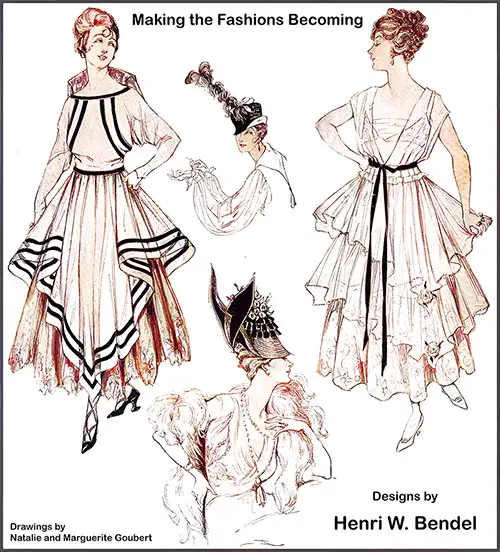
Making the Fashions Becoming by Henri W. Bendel. Drawings by Natalie and Marguerite Goubert, Designs by Henri W. Bendel. Harper's Bazar, March 1916, p. 68. GGA Image ID # 1ca4a4c79d
Bendel has developed a striking but not less artistic afternoon frock from black lace and Georgette crêpe in a lovely shade of blue. The note of black is repeated in the black velvet ribbon trimming on the crêpe. An upstanding collar of the face is attractive and harmonious.
For a recent bride, Bendel draped two flounces of blue chiffon over a petticoat of silver face and dropped a silver rose on the Mingest point of each ruffle. Little frills at the waistline give the bodice of chiffon and lace a quaint little touch. Blue is a ribbon shot with silver at the waistline.
Moss rosebuds and loops of black straw cover the crown of a black Milan hat. Black straw faces the cross-points that give this unusual hat an air of distinction. The gold-brimmed turban of black Milan straw, faced with an old blue faille, achieves added height by a quill of tufted black feathers (upper center).
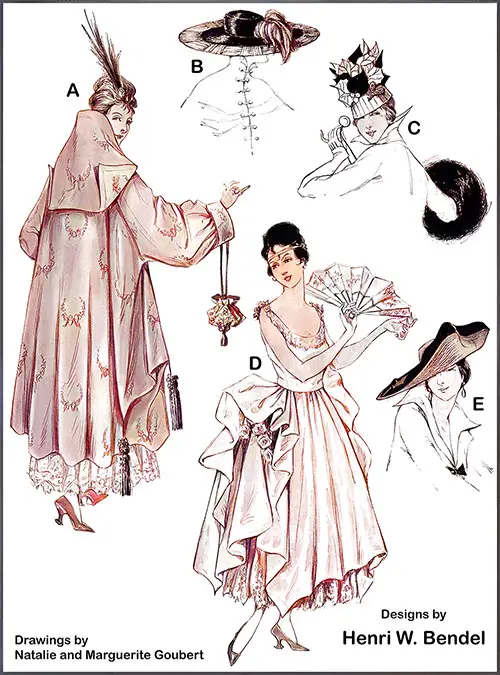
More Fashion Designs by Henri W. Bendel. Drawings by Natalie and Marguerite Goubert. Harper's Bazar, March 1916, p. 69. GGA Image ID # 1c55a5c9d2
(A) Heavy Gold Tassels Weighting the Points and a Deep Shawl Collar With Turned Back Corners Are Interesting Features in This Evening Coat of Rose Faille Brocade. The Voluminous Sleeves Have Demure Little Cuffs That Strike a New Note in Their Severity.
(B) A Large Black Liséré Sailor Has Half Its Brim Covered With Blue Ostrich Feathers Arranged in Blocks (Upper Center). Tips of Ostrich Fair at the Right of the Front and Cart Over the Edge of the Brim.
(C) Again the High Crown: Of Bright Rose-Colored Fancy Straw, This Close-Fitting Turban Has a Crown of Green and Black Ivy Leaves.
(D) A Tight-Fitting, Round-Necked Sleeveless Bodice With an Elaborately Draped Skirt Is in Keeping With the Most Advanced Fashion Tendencies. Over a Petticoat of Silver Lace, Bendel Drapes Faille à la Panier in Pastel Shades. Blush Roses: Hold the Narrow Bertha on the Shoulders and Emphasize the Skirt Drapery.
(E) A Place High in Feminine Favor Is Predicted for This Black Liséré Hat With Its Graceful Lines. The Brim Is Entirely Covered by a Deep Ruching of Black Velvet Rises Slightly Above It in the Front.
Never before was there such a triumph for originality and art! Out of chaos, the French designer, by sheer merit and ability, created the modern school of dressmaking. Perhaps the past heritage has contributed as much to the preeminence of this authority as individual ability and the influence of that beauty, Paris.
For centuries, children have been trained in the art of making delicate laces, embroideries, and tapestries. This training is amplified by a culture inbred by contact with remarkable works of art and access to libraries from which ideas can be obtained and transmuted into new forms.
Then there is Paris's atmosphere and spirit, emanating good taste in all things. And by no means least is a fine appreciation of the fitness of things. As for the future of fashion, it will be, as I said at the beginning, Paris forever! Her sovereignty is the gift of temperament and tradition. The supremacy she enjoys cannot be successfully assailed.

Tea Gown and Charming Toque by Henri Bendel. Drawings by Natalie and Marguerite Goubert. Harper's Bazar, September 1916, p. 69. GGA Image ID # 1ca4c63fc7
A luxurious evening cape made of metal brocade in rose, blue, and silver is adorned with white crystals and a Russian sable collar. It is lined with layers of pale rose and yellow chiffon. The charming tea gown on the upper left is crafted from numerous layers of yellow chiffon trimmed with silver braid.
The gathered overdress and angel sleeves are silver lace edged with ermine. The small black velvet hat remains popular. Bendel has created an appealing toque with an unusual canopy crown of wired black lace. Guerra, naturally, provides the trimming.
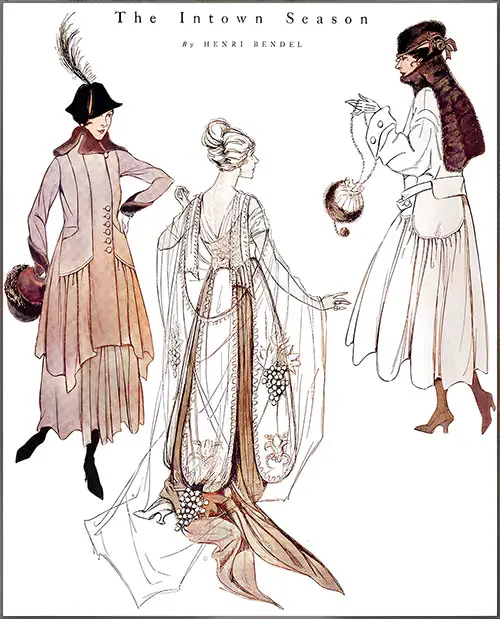
The Intown Season -- Fashions by Henri Bendel. Harper's Bazar, November 1916, p. 78. GGA Image ID # 1ca55dfaea
Taupe velours are successfully featured in this walking suit, the pièce de résistance of the winter wardrobe. Mole fur is used for the collar and cuffs and is combined with skunk for the muff. The black velvet hat is unusual in having a square brim faced with gold. A paradise plume gives added height.
Bendel uses Duvetyn, a most satisfactory material for the indispensable long coat, in a very stylish mahogany model. A black beaver hat trimmed with a broad band of kolinsky has a blue ribbon bow and a pink rose at the back. The handbag is made of mahogany silk and kolinsky.
Gold is the color par excellence this season, producing truly regal effects, such as this gown of gold velvet and white satin. The satin panels and bodice are gold, and the tulle scarf is heavily embroidered with silver.
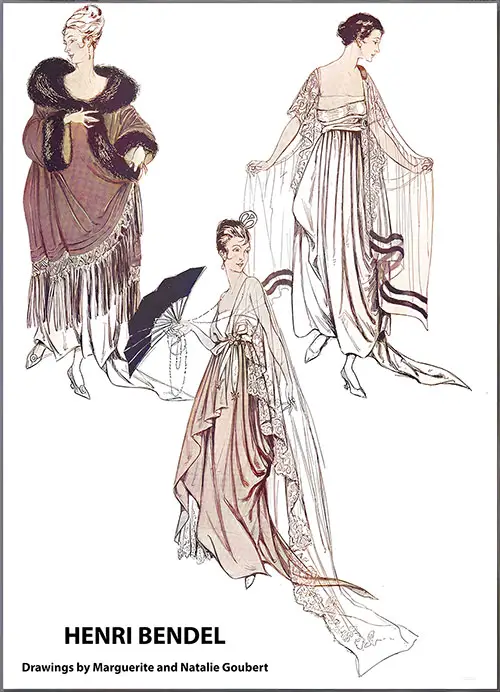
More Fashions For the Intown Season by Henri Bendel. Harper's Bazar, November 1916, p. 79. GGA Image ID # 1ca55f277d
This walking suit successfully features taupe velours—the pièce de résistance of the winter wardrobe. Mole fur is used for the collar and cuffs and is combined with a skunk for the muff. The black velvet hat is unusual in having a square brim faced with gold. A paradise plume gives added height.
Bendel uses Duvetyn, a most satisfactory material for the indispensable long coat, in a very stylish mahogany model. A black beaver hat, trimmed with a broad band of kolinsky, has a blue ribbon bow and a pink rose at the back. The handbag is made of mahogany silk and kolinsky.
Gold is the color par excellence this season, producing genuinely regal effects, such as in this gown of gold velvet and white satin. The satin panels and bodice are gold, and the tulle scarf is heavily embroidered with silver.
Henri Bendel, "The Intown Season," in Harper's Bazar, November 1916, p. 78-79.
